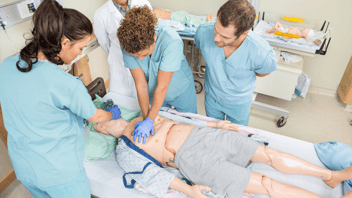Simulation is an essential tool to help students develop and refine their clinical judgment, muscle memory for psychomotor skills, and teamwork and communication skills. It provides an opportunity for students to gain experience in high volume, low risk situations. Finally, simulation ensures that students receive exposure to specific patient cases rather than hoping they will have that key experience in their clinical placements.
Simulation can come in several different forms. Just like there are different tools for cleaning around your house (think upright vacuum vs dustbuster vs a plain old broom), all of these simulation modalities have their place in your educational toolbox or “cleaning closet.”
After 15 years teaching in nursing simulation labs, I’ve seen these different modalities used hundreds of times. I’ve seen what students respond to best in different situations and how each of these modalities lead to the best student learning outcomes. Nursing education programs can benefit from any one of these tools, but having them all doesn’t necessarily translate directly to success. Without the support of a multi-person simulation team, underutilized equipment will become outdated while waiting for enough “free time” to learn to use it, maintain it, and provide user training to faculty and students.
Pros and Cons, Part 1
#1: Static Manikins
Nearly every sim lab has at least one of these workhorses stuffed in the corner of the lab, and in my opinion, they don’t get nearly as much respect as they deserve! I have used static manikins for all kinds of situations where it isn’t physically or financially wise to use your lab’s expensive, high fidelity manikins. For example, a static manikin can be used to simulate:
- A drug overdose simulation where the victim is found on the ground
- A “suicide watch” room in which the learners need to search for hidden lethal means. In this case, the manikin patient isn’t the star of the show, but its presence is important in the search for contraband.
- Messy simulations where simulated “body fluids” might pose a risk to the sensitive electronics of the high fidelity manikins.
Static manikins are best used for simulating basic nursing care such as bathing, turning, and positioning; occupied bed making; dressing changes; NG insertion; Foley catheter insertion; medication administration, locating injection sites; and situations in which a large number of students will need hands-on practice at the same time, such as an open lab. They are a great overall solution for low resource schools with limited budgets and minimal lab teams.
|
Static Manikin Pros |
Static Manikin Cons |
|
|
#2: High Fidelity Manikin
High fidelity manikins are more expensive and complex than static manikins, but that complexity adds value to the students’ learning experience. I often use high fidelity manikins for interdisciplinary simulation scenarios that are low volume and high risk. The team can practice effective communication while receiving immediate feedback from the manikin, such as vital signs and the presence of sweating, bleeding, or cyanosis. The level of engagement led to high evaluations. This article talks more about the pros and cons of high fidelity simulations.
|
HF Manikin Pros |
HF Manikin Cons |
|
|
#3: Standardized Patients
Standardized patients are hired and trained actors who play the role of specific patient cases. There is nothing more real and human-like in simulation than humans! With standardized patients, it’s crucial to ensure the person is well-trained. They should be able to portray the same case in the same way over and over and over again, which isn’t as easy to control as it is with manikins and other modalities. SP’s can be a patient, a family member, or even a “co-worker” to support a wide range of learning objectives. I routinely used a standardized patient to provide a patient fall scenario for new employee orientation. Learners were able to put into action what they had just reviewed in the policies and procedures, and it helped the learners who were less enthusiastic about the dry reading of policies to see them in action, highlighting the importance of each step in caring for a patient who sustained a fall.
Note that “free” volunteers may be easier on the program’s budget, but if they don’t take direction well or disregard the learning objectives, it can derail the simulation. Poor simulations with SPs can damage the psychological safety of the learners, which takes a lot of work to build and even more work to repair.
|
Standardized Patient Pros |
Standardized Patient Cons |
|
|
Let’s Review
We’ve talked about static and high fidelity manikins, as well as standardized patients. Let’s review the pros and cons.
- Static manikins are great for lower level and “messy” skills that could damage a high fidelity manikin. They are not great at giving feedback, such as vital signs, assessment sounds, or speech, without the help of supplemental equipment to provide that feedback.
- High fidelity manikins are great for portraying all kinds of assessment findings and are particularly helpful in interdisciplinary simulations. They are not great for moving into certain positions and are too expensive to be used for some skills that a task trainer could handle.
- Standardized patients are as real as you can get. Well trained SPs are wonderful for interviewing, showing emotion, practicing therapeutic communication, and providing learners feedback on how it felt to be their patient. Invasive procedures can only be done with the addition of wearable task trainers, if at all.
In our next post, we’ll talk about task trainers, VR, and computer-based simulation modalities. Meanwhile, leave us a comment and tell us: Which of these modalities have you tried? Which is your favorite?



